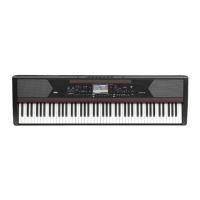194| Recording the Styles
What happens when you play a chord…
To summarize, when you play a chord on the chord recognition area, the
arranger determines which Style Element is used, then determines which
Chord Variation should be used for the played chord, then Style sequenc-
es for every track of that Chord Variation are transposed from the original
chord to the recognized chord, and so on every time you play a chord.
Ordinary, Guitar and Drum tracks
There are different types of tracks, and each of them is treated in a different
way by the arranger:
Track type Meaning
Acc (Accompaniment) When a chord is recognized, the programmed chord notes
are transposed to a suitable scale, according to the Note
Transposition Tables (NTT) The NTT allows you to record
just some Chord Variations, and have all the notes play in
the right place, avoiding dissonances and transposing the
pattern notes to the notes of the recognized chord.
Bass
Drum No transposition is applied.The original pattern plays al-
ways.
Perc (Percussion)
Gtr (Guitar) When a chord is recognized, the arranger triggers single
notes, strumming and arpeggios on a “virtual guitar”,
keeping care of the way notes are played on the guitar
fretboard. Note that inside a Guitar track you can also
have some parts typical of an Acc track – a useful addi-
tion for short “free-form” passages.
What to record in a Style
Recording a Style means recording tracks, inside a series of Chord Variations,
inside a series of Style Elements, inside the Style itself.
You don’t have to record all Chord Variations for all Style Elements. It is of-
ten only needed to record a single Chord Variation for each Style Element.
Exceptions are the Intro 1 and Ending 1, where we suggest to record both a
Major and minor Chord Variations.

